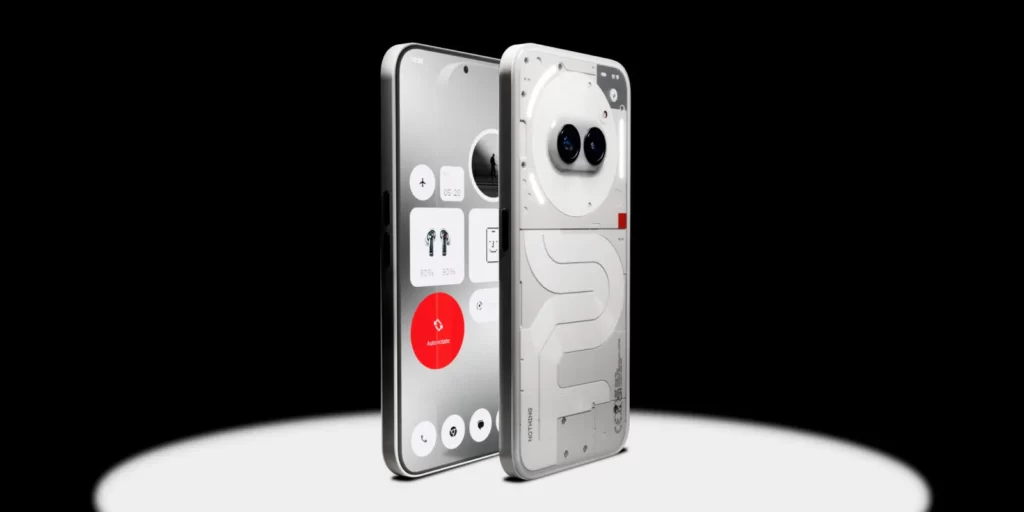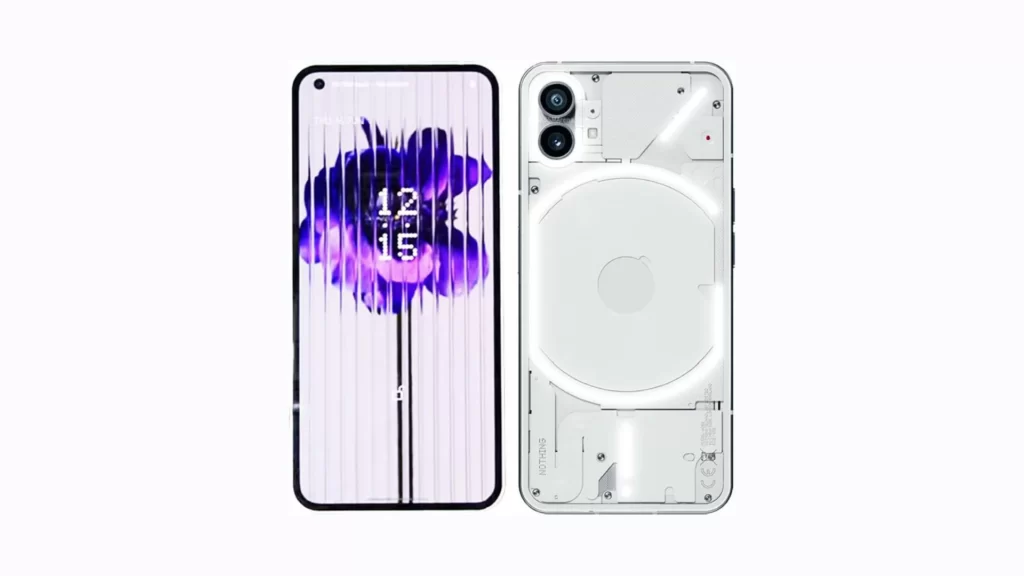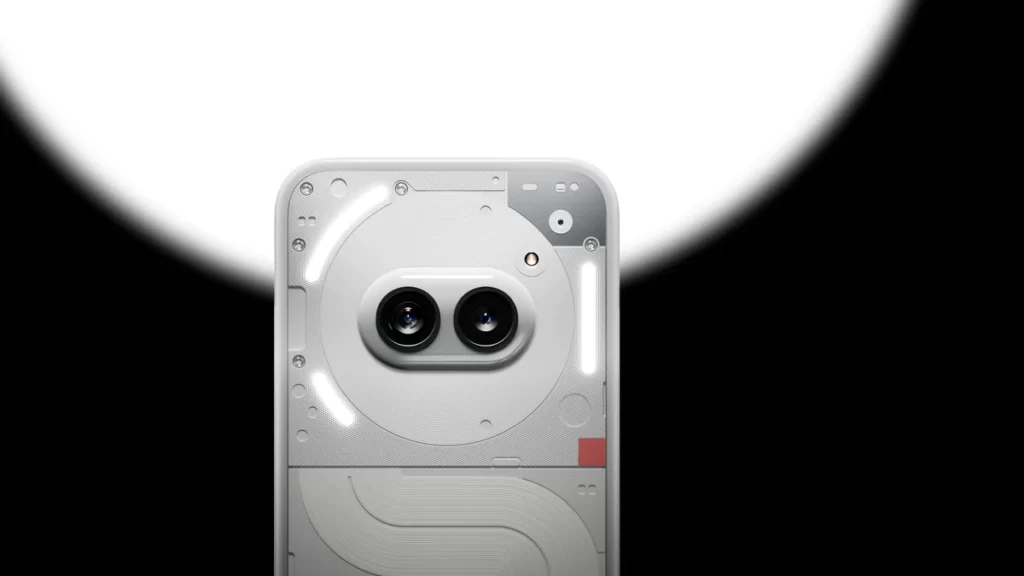Since the release of its first model in 2022, Nothing has come an impressive distance in the smartphone field. With the introduction of the Nothing Phone (2a), it’s time to look at the major developments, including design, display, performance, shooting and battery management between the two versions.
The first big change between the Nothing Phone (2a) and the Nothing Phone (1) is the design
Place the Nothing Phone (2a) and the Nothing Phone (1) side by side, and the first difference that jumps out at you is their size. The Nothing Phone (2a) is not only thinner than its predecessor, but it also sports a larger 6.7-inch screen, compared to the 6.55-inch screen of the Nothing Phone (1). This increase in size provides a more immersive and comfortable viewing experience for users.

The back of the Nothing Phone (1) highlights the internal components of the smartphone, including the screws, the copper coil dedicated to wireless charging and the dual photo sensor, visible under the transparent shell. LED lights are arranged around the coil to indicate incoming calls and messages, adding a touch of modernity and personalization to the design.
The Nothing Phone (2a) retains the design lines of the series with a transparent back, but with a more subtle approach to the Glyph interface. Unlike the Nothing Phone (2) which has 11 LEDs, the Nothing Phone (2a) has just three LEDs around the central camera module on the back. Although these LEDs continue to provide indications for calls and texts, as well as serving as a timer, they offer a less bold and less customizable visual experience than those of its high-end predecessor.
Improvements in terms of display of the Nothing Phone (2a)
In addition to its size, the Nothing Phone (2a) has significant improvements in terms of screen specifications. With a typical brightness of 700 nits and an impressive peak brightness of 1,300 nits, the Nothing Phone (2a) outperforms its predecessor on this front. Comparatively, the Nothing Phone (1) offers a typical brightness of 500 nits and a peak brightness of 1,200 nits. These improvements ensure a vibrant visual experience even in the brightest environments.

Another important aspect to consider is the screen refresh rate. While both models offer variable 120Hz refresh rates for smooth scrolling, the Nothing Phone (2a) takes it a step further. It can now go down to 30Hz, providing increased flexibility and allowing more efficient battery usage when maximum performance is not required. In contrast, the Nothing Phone (1) is limited to 60Hz in its refresh rate reduction capability.
Improved performance for the Nothing Phone (2a) compared to the Phone (1)
With the move from Nothing Phone (1) to Nothing Phone (2a), users can expect significant improvements in this area. The Nothing Phone (1) was powered by the Qualcomm Snapdragon 778G+, while its successor, the Nothing Phone (2a), runs on the MediaTek Dimensity 7200 Pro. This transition to the MediaTek chip promises increased performance with optimal energy efficiency.
The Nothing Phone (2a) shows higher clock speeds compared to the Nothing Phone (1). This results in faster multitasking and improved responsiveness. Recently, Nothing claimed that the Phone (2a) is 13% more powerful and 16% more efficient than its predecessor, highlighting the performance gains made.
Another notable innovation on the Nothing Phone (2a) is Smart Clean technology. This feature aims to double the read and write speeds compared to the Nothing Phone (1), providing a smoother and more responsive user experience. App opening speeds should also be twice as fast on the Phone (2a), which is a significant improvement for efficiency-hungry users.
Nothing Phone (2a) and Nothing Phone (1) camera comparison
Camera quality is a crucial consideration for many users, and while both phones sport 50-megapixel rear cameras, the Nothing Phone (2a) stands out with a main camera sensor capable of holding 13,500 electrons. more than that of the Nothing Phone (1). This increased capacity ensures clearer, sharper images, even in low light or motion conditions.

The Nothing Phone (2a) also offers a significant improvement to its front camera. With a resolution of 32 megapixels, it offers 27% increased light sensitivity compared to the Nothing Phone’s 16 megapixel selfie camera (1). This increase in resolution means more detail and clarity in your selfies, for even sharper memories.
Aside from the hardware differences, the Nothing Phone (2a) also benefits from improved image processing technologies. These improvements help optimize the quality of photos and videos, ensuring vibrant colors, sharp contrasts and reduced noise, even in low light conditions.
Comparison of battery life and charging between the Nothing Phone (2a) and the Nothing Phone (1)
One of the most significant things that sets the Nothing Phone (2a) apart from the Nothing Phone (1) is their battery size. The Phone (2a) has a larger 5,000 mAh battery, while the Phone (1) has a 4,500 mAh battery. This increase in capacity promises increased battery life for Phone (2a) users, allowing extended use without having to worry about frequent recharging.
When it comes to charging speed, the Nothing Phone (2a) takes the edge with 45W fast charging support, compared to the 33W available on the Nothing Phone (1). This faster charging capability allows users to quickly recharge their phone, providing increased convenience for those on the go or in an emergency situation.
Another notable improvement over the Nothing Phone (2a) is its increased battery life. According to data provided by Nothing, the Phone (2a) retains more than 90% of its maximum capacity after three years of daily charging, which represents an increase of more than 25% compared to the Phone (1). Additionally, the Phone (2a) stays 13% cooler while charging, helping to preserve long-term battery health.
Related :
- Nothing Phone (2a) vs Nothing Phone (2)
- Nothing Phone (2a) vs Google Pixel 7a: Which is right for you?
